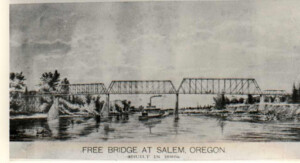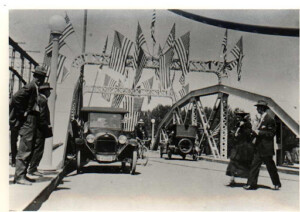Salem’s Bridges

Photo of drawing: “Free Bridge at Salem, Oregon, built in 1886”.
Steel truss structure on concrete piers, crossing Willamette River.
Stern Wheel Riverboat pictured passing under bridge., WHC Collections 0083.006.0017.032
Salem has over 100 bridges including those over creeks and roads, but its most important ones are those over the river that runs through it, the Willamette.
The history of the bridges over the Willamette River begins in December 1886 with the opening of the first Center Street Bridge. It was felt necessary to tie Salem and West Salem together. Before that time the only river crossing was by ferry. This was the first bridge over the Willamette anywhere in Oregon, the Morrison Street Bridge in Portland not opening until April of 1887. That first bridge cost $49,901 and was constructed mostly of wood. It was located in the wrong position in relation to river currents and collapsed with a crash on February 3, 1890 during a flood.
Salem’s next bridge was opened on January 13, 1891. It was a willowy affair that was deemed unsafe almost before the paint was dry. It was not replaced, though, until 1918.

Cars and People on flag decorated bridge over the Willamette River. Pedestrians on sidewalk and walking across street. Cars and bicycle in roadway. about 18 flags. WHC Collections0083.006.0017.031
This third Center Street Bridge was dedicated in a burst of patriotic fervor on July 30, 1918. The historical record shows that Frank Davey delivered the dedication address. Program Chairman was F.T. Wrightman assisted by W.H. Dancy. Others helping were Frank Smith, Marshal; Charles Archered was Auctioneer; and Henry W. Myers, head of the Willamette chapter of the American Red Cross. The Red Cross was the beneficiary of the $3000 raised by the various concessions. These included postcards, lunches, and the privileges of being first. Chas. H. Vick and Elbert A. Thompson paid $500 to be the first to drive a vehicle across the bridge. The vehicle in question was a Fordson tractor. Mr. Vick owned the agency it came from. There was an afternoon parade that day and the local newspaper reported that an estimated 20,000 people watched it. (Salem’s population at that time was about that number). Dedication of the bridge was on a platform underneath the east approach to the bridge. Following the dedication two Red Cross workers, Miss Catherine Fowle and Miss Gladys Bartholomew, raised semaphores allowing traffic to pass. “Little Miss Rowena Eyre” either scattered flowers on the roadway or pulled a ribbon that released them. Mrs. William Colder of Polk County paid $100 to be the first to turn on the lights illuminating the bridge.
Then, on December 14, 1952 a Marion Street bridge was added. Construction took nearly three years and it was opened without ceremony. At the time it was the longest bridge of its type west of the Mississippi. To the south, though technically not in the city, the Independence Bridge also spans the Willamette. Governor Douglas McKay dedicated this bridge on December 18, 1950. During the dedication ceremonies Verd Hill, age 74, died suddenly of heart failure.
Although not a bridge over a river, the 17th Street overpass, opened in the 1980s, further increased the ability of Salemites to travel from one part of the city to another. Before this overpass opened trains on the north-south railroad tracks occasionally blocked access in an east-west direction. An abandoned railroad bridge over the Willamette still stands. The bridges, particularly those over the Willamette, have helped integrate the City of Salem.
Compiled and written by Dick Lutz
Bibliography:
Capital Journal, 2-1-50, 10-7-50, and11-24-52
This article originally appeared on the original Salem Online History site and has not been updated since 2006.







Leave A Comment